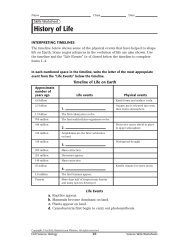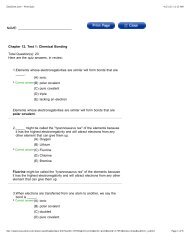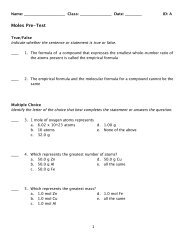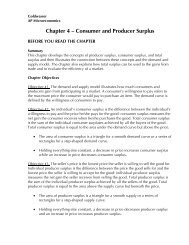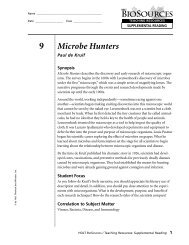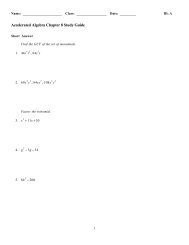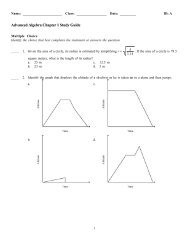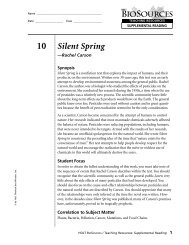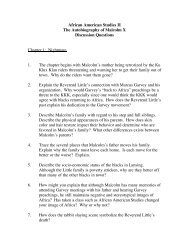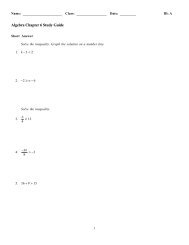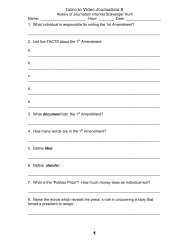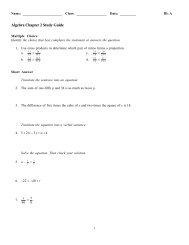The Double Helix Book Report Worksheet.pdf
The Double Helix Book Report Worksheet.pdf
The Double Helix Book Report Worksheet.pdf
- No tags were found...
Create successful ePaper yourself
Turn your PDF publications into a flip-book with our unique Google optimized e-Paper software.
Name _______________________________________________________Date _______________________Class ________________________TEACHING RESOURCESSUPPLEMENTAL READING3<strong>The</strong> <strong>Double</strong> <strong>Helix</strong>A Personal Account of the Discovery of theStructure of DNA—James D. WatsonCorrelation to Subject Matter<strong>The</strong> <strong>Double</strong> <strong>Helix</strong> is James D. Watson’s personal account of his discovery of themolecular structure of DNA, for which he won the Nobel Prize, along withMaurice Wilkins and Francis Crick. Watson and Crick, who worked together asresearch scientists in the new field of molecular biology during the 1950s,returned again and again to the problem of understanding the structure of theDNA molecule.<strong>The</strong> progress and success of other scientists—including Linus Pauling and hismodel of the alpha-helix, and other associates who were using X-ray photographsto look at the DNA structure—contributed to the DNA research ofmany scientists.Watson became curious about the structure of DNA while still an undergraduate,but his lack of interest in chemistry or physics hindered his work on theproblem. <strong>The</strong> collaboration of the two scientists enabled them to understand thenature of DNA and figure out its structure. Watson and Crick created a modelbased on special X-ray photographs that indicated the helical structure. <strong>The</strong>irmodel proved the molecular nature of DNA and therefore confirmed its twostranded,helical structure.© by Holt, Rinehart and Winston, Inc.Student FocusIn this book you will experience the literary nonfiction elements of narrative andbiography. Focus on the topics of scientific inquiry and method as well. How didWatson develop his original hypotheses about the structure of DNA despite hisreluctance to learn the essential chemistry and physics? Describe the collaborativework of Watson and Crick, along with other scientists.Correlation to Subject MatterBiochemistry, Molecular Biology, Physics, and GeneticsHOLT BIOSOURCES / Teaching Resources: Supplemental Reading 1
SUPPLEMENTAL READING<strong>The</strong> <strong>Double</strong> <strong>Helix</strong>continuedAnalyzing the <strong>Book</strong>IdentifyingFacts1. Describe Francis Crick’s personality and approach to science.2. What results of O.T. Avery’s experiments indicated that genes were not specialtypes of protein molecules? How did this contradict Erwin Schrodinger’s theoryabout genes?3. <strong>The</strong>re was skepticism on the part of some scientists regarding DNA as thecomposition of genes. What information did Crick think DNA would provideabout genes?4. When did Watson become interested in DNA? How did he pursue his interest?5. What did Watson learn from Maurice Wilkins’s talk in Naples? Why did Watsonwant to associate himself with Wilkins?© by Holt, Rinehart and Winston, Inc.2 HOLT BIOSOURCES / Teaching Resources: Supplemental Reading
SUPPLEMENTAL READING continued Name _______________________________________________________<strong>The</strong> <strong>Double</strong> <strong>Helix</strong>Date _______________________ Class ________________________6. Describe Linus Pauling’s explanation of the alpha-helix. What did Watsonobserve about Pauling’s discovery of the helix?7. Based upon X-ray data, what hypothesis about the nature of DNA didWilkins share with Crick?8. How did Wilkins differ from Watson and Crick in their approach to solvingthe DNA problem? What prevented Wilkins from continuing his approachto research?© by Holt, Rinehart and Winston, Inc.9. Rosalind Franklin’s early X-ray data showed the DNA molecule to be compatiblewith two, three or four polynucleotide chains, or strands. How did Crickdetermine that there were a small number of solutions that corroboratedinformation with which he and Watson were working? Why could no cleardetermination about the number of strands be made at this point?HOLT BIOSOURCES / Teaching Resources: Supplemental Reading 3
SUPPLEMENTAL READING<strong>The</strong> <strong>Double</strong> <strong>Helix</strong>continued10. When attempting to determine what neutralized the negative charges ofthe phosphate groups of the DNA backbone, Pauling had an edge over theWatson-Crick team. Why?11. Describe the first DNA-model attempts that Watson and Crick made.12. Why did Watson choose to work on the structure of TMV? What did helearn from TMV that he could apply to his DNA search?© by Holt, Rinehart and Winston, Inc.4 HOLT BIOSOURCES / Teaching Resources: Supplemental Reading
SUPPLEMENTAL READING continued Name _______________________________________________________<strong>The</strong> <strong>Double</strong> <strong>Helix</strong>Date _______________________ Class ________________________13. What error did Watson discover in Pauling’s DNA model that was composedof a three-chain helix with the sugar-phosphate backbone in the center?14. What was wrong with Watson’s hypothesis that gene replication could beachieved if each base in the newly synthesized chain hydrogen-bonded to anidentical base? How did he solve the problem?InterpretingMeanings15. Give examples of the competition that developed as the scientists worked tosolve the problem of DNA structure.© by Holt, Rinehart and Winston, Inc.16. How did Pauling’s discovery of the alpha-helix and subsequent work onDNA affect the work of Watson and Crick?HOLT BIOSOURCES / Teaching Resources: Supplemental Reading 5
SUPPLEMENTAL READING continued Name _______________________________________________________<strong>The</strong> <strong>Double</strong> <strong>Helix</strong>Date _______________________ Class ________________________22. What was the main difference between Pauling’s attempts to build the DNAstructure and the final, successful attempt of Watson and Crick?23. Give some examples of Watson’s desire to be the first scientist to solve DNA.How did this desire affect his work?24. By the time they were finished, Watson and Crick had used elements of biology,chemistry, mathematics, engineering, and common sense to discoverthe structure of DNA. Why did the structure of a single molecule require allof these areas?© by Holt, Rinehart and Winston, Inc.ApplyingMeanings25. Explain the importance of hydrogen bonding to the structure of DNA.HOLT BIOSOURCES / Teaching Resources: Supplemental Reading 7
SUPPLEMENTAL READING<strong>The</strong> <strong>Double</strong> <strong>Helix</strong>continuedWriting About the <strong>Book</strong>On a separate sheet of paper, write the answers to each of the following.Extending the Story1. Watson and Crick’s discovery of the structure of DNA opened the door forfurther genetic research that has lead to current use of DNA testing for manypurposes. Imagine that you are Watson. Write a short narrative in which youextend his story by hypothesizing about future uses of DNA testing.Thinking about Assumptions2. Throughout the time of the research on DNA, Rosalind Franklin assumedthat DNA was not a helical structure. Since she was in a position to producethe best X-ray data on DNA, her assumption directly affected the researchefforts to discover its structure. Write a summary of how the research processmight have differed had Franklin assumed that the DNA molecule was ahelix.Responding to a Review3. <strong>The</strong> <strong>Double</strong> <strong>Helix</strong> was published amid controversy over Watson’s forthrightportrayal of his colleagues. <strong>The</strong> Harvard University Press refused to publishthe book. <strong>The</strong> Harvard Crimson commented editorially that such a work was“bound to offend somebody.” Write an essay in which you react to this statement.Do you think Watson’s book is offensive to anyone? Were his commentsabout his colleagues necessary for him to tell the story? Cite examplesfrom the book to support your opinion.Evaluating a Character4. James Watson would not have been able to complete the structure of DNAwithout Francis Crick. Write a description of their joint discovery fromCrick’s perspective.Writing a Journal Entry5. Suppose that you are a scientist working on the problem of DNA during thetime that Watson and Crick discover the structure. You have just heard andseen a presentation by these two men, detailing the DNA structure. Write anentry in your journal describing your response to their discovery and whyyou think it is important.Analyzing the Discovery6. If you were James Watson what would you think and feel about your discovery?Was there a step in the process that you feel led directly to discovering thestructure of DNA? Cite examples that support your response. Do you feel thatLinus Pauling, Maurice Wilkins, and Rosalind Franklin deserve part of thecredit for their work on the problem? Which parts of their work, and why?© by Holt, Rinehart and Winston, Inc.8 HOLT BIOSOURCES / Teaching Resources: Supplemental Reading
SUPPLEMENTAL READING continued Name _______________________________________________________<strong>The</strong> <strong>Double</strong> <strong>Helix</strong>Date _______________________ Class ________________________Testing on the <strong>Book</strong>On a separate sheet of paper, write the answers to each of the following.Critical Thinking and Writing1. Watson states, “<strong>The</strong>re had been far too many days when Francis and I worriedthat the DNA structure might turn out to be superficially very dull,suggesting nothing about either its replication or its function in controllingbiochemistry.” Why would this type of finding have been such a disappointmentto them?2. <strong>The</strong> personalities of both Watson and Crick, as well as their friendship, contributedto their research abilities. Cite examples of how these nonscientificaspects affected the discovery of the DNA structure.3. <strong>The</strong> structure of DNA is considered one of the major scientific discoveriesof the twentieth century. Why? Describe another scientific discovery thatyou feel is as important. Include a brief profile of the scientist(s) who madethe discovery.4. Watson did not possess extensive mathematical knowledge, and neither henor Crick was as proficient in chemistry as Linus Pauling. How were they ableto circumvent these deficiencies?5. <strong>The</strong> <strong>Double</strong> <strong>Helix</strong> is Watson’s personal history of the discovery of the structureof DNA. Is it an accurate historical account?© by Holt, Rinehart and Winston, Inc.HOLT BIOSOURCES / Teaching Resources: Supplemental Reading 9



